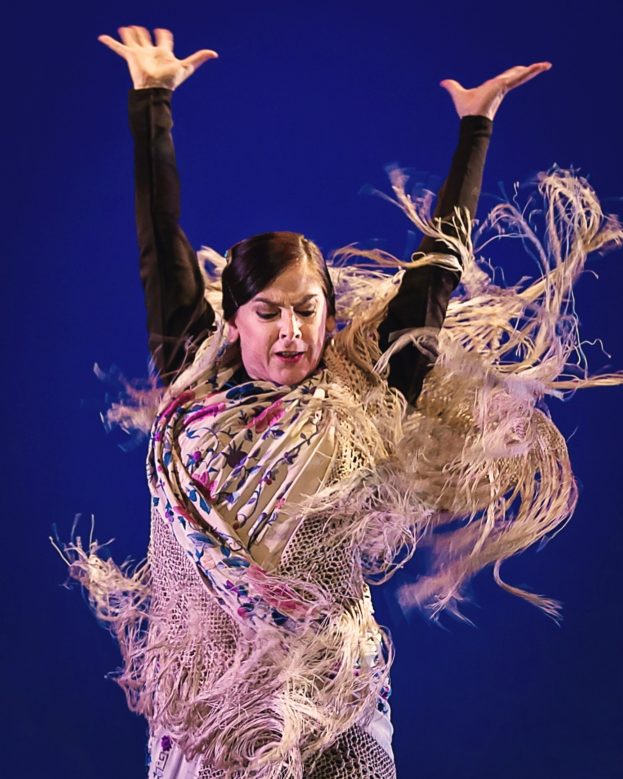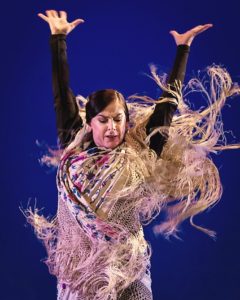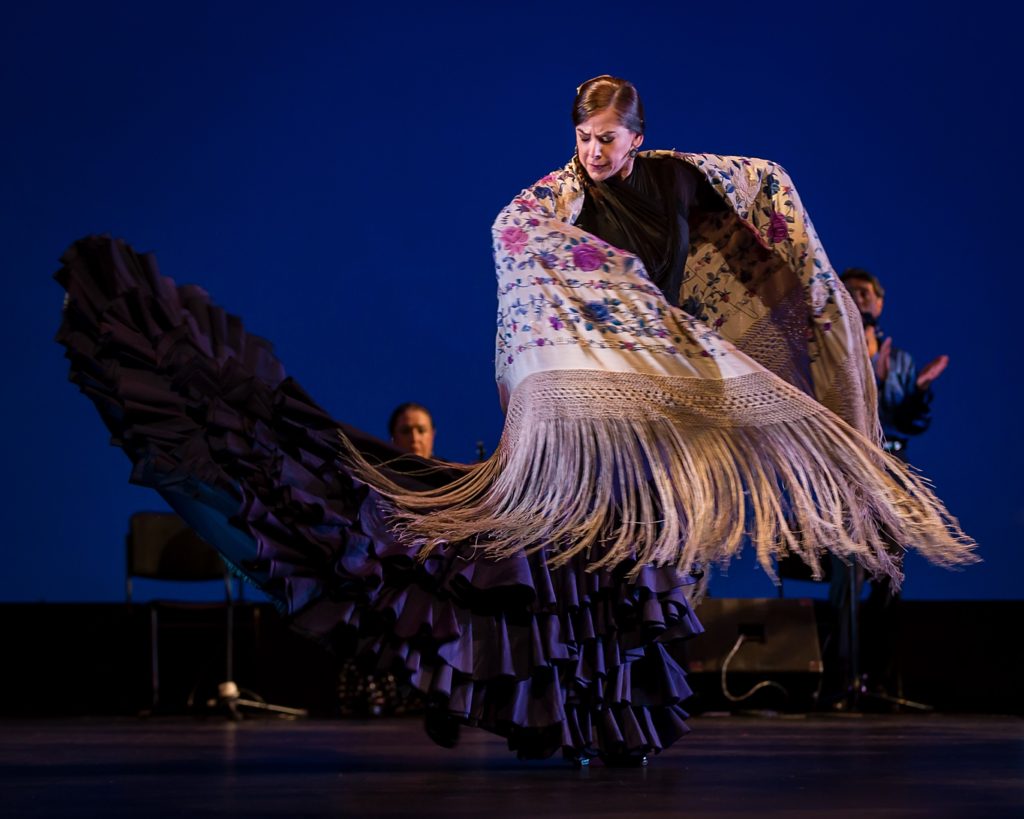

The ink on the lease to the newly acquired studio in San Francisco’s Mission District was barely dry when I sat to talk with artistic director Carola Zertuche’s about her guidance of Theatre Flamenco of San Francisco through its 50th year, and the new show the company is preparing to present during their November home season: El Latir del Tiempo / The Beat of Time.
Carola speaks in precise, clipped tones, and is intensely friendly, emanating a fierceness that befits a Flamenco dancer, which in no way detracts from her approachability. Born and raised in Torreón, Mexico, she was introduced to classic Spanish dance as a child. She was introduced to Flamenco when her mother sent her to ballet class as a young girl. As she describes it, “I was bored in Ballet and I could hear the Flamenco class next door, so I begged my mother to put me in Flamenco.”
The match was lit, and at the age of 16 she traveled to Mexico City, where she began her career at the Flamenco nightclub Tablao Mesón de Triana (a Tablao is a type of intimate nightclub where Flamenco is most often performed). She toured internationally, before deciding to settle in San Francisco in the late 90s for the diversity of dance experiences the region offers. “The dance community is super strong here,” she says. “I go to see the modern dance companies, the ballet, ethnic dance. All kinds of dance is practiced here and it is what attracted me to the region.”
She performed in nightclubs in San Francisco, and as a featured soloist in larger Flamenco companies. In the late 90s she began performing with Theatre Flamenco under the direction of Miguel Santos. Founded in 1966 by Adela Clara, Theatre Flamenco was the first U.S. company to stage full productions of Spanish dance, and proudly declares that they are San Francisco’s second oldest dance company (after the San Francisco Ballet). Santos had started dancing with the company at the beginning, and had been artistic director from 1987 to 2007.
Carola tells me that Santos first “invited me to perform as a dancer, and then he started inviting me as a choreographer. I would create a number for the company each home season. And then after three or four years,” he came to her and, “asked if I wanted to take over the company.” Carola leapt at the opportunity, in large part because it gave her an opportunity to drastically expand the scope of her choreography.
She explains, “I really like to perform in the [intimate spaces provided by] Tablaos, but people think Flamenco is just for the small venue, and that just is not true. In the theater you can really create something different. You have all these elements – lighting, sound, production design. And that was exciting for me. And then there’s the challenge of having to create something new every year [for the company’s home season].
There is some irony in the fact that over the past decade, as many dance companies have explored ways they can break their proscenium shackles and perform outside of traditional theater settings, Carola has been pushing Theatre Flamenco to excel as a company that performs on a proscenium stage. “The dance that is created for the Tablaos is a very beautiful thing, but when you go to the theater you have to use the theater.” In Theatre Flamenco performances, group numbers and duets are usually set for the stage with specific movements and timing, but solo performances in her show maintains the tradition of improvisation.

So while El Latir del Tiempo / The Beat of Time acknowledges and celebrates the company’s 50 years of existence, and the continuity of their mission to present the artistry of Flamenco in large scale theatrical productions, it is also a celebration of Carola’s 10 year tenure as artistic director.
Santos had developed the company towards large-scale, community-focused presentations, and “it was very beautiful what he was doing, but [Santos’ vision was] focused on students and teaching.” Carola had a slightly different vision and wanted to shift more towards employing full-time Flamenco dancers – a company with dancers that could dedicate more time to the artform.
According to the philosophy of Carola Zertuche, “If you do Flamenco, you are waking up with Flamenco and going to sleep with Flamenco. You have to have a very deep knowledge,” in order to perform with Theatre Flamenco.
“I said if I take the company, I really want to take it to another level.” She aspired to bring Theatre Flamenco to a level of quality she associated with Bay Area choreographers like Alonzo King and Margaret Jenkins. While the dance vocabulary is different, she pushes the company to maintain the same caliber of physicality and technique that she sees taking place in the larger ecosystem of San Francisco’s professional dance community.
Carola has also worked to expand the caliber of musicians Theatre Flamenco engages in their productions, especially bringing in skilled musicians and singers from Spain. For the shows this November, this expanded caliber includes Flamenco singer Juana la del Pipa who is part of a dynasty of artists from the Flamenco cradle of Jerez de la Frontera in Southern Spain.
“I want to show the direction of the company is still very tied to traditional Flamenco, which is why I’m bringing Juana, who is very traditional. Her way of singing is so personal and she is one of the last singers to sing that way. To be on the stage with her is amazing.” Carola expands on why it’s important to bring artists like this to broader audiences: “I bring this kind of artist to show what’s going on in Spain. To show people that it’s more than just polka dots and flowers and the Gipsy Kings.”
Another guest is Pastora Galván, who made her professional dance debut with Theatre Flamenco at the age of 15, before becoming an international star of Flamenco over the past several decades. This will be Galván’s third time guesting with Theatre Flamenco, although she’s danced in shows Carola produced before as a solo artist.
Carola describes the powerful impression Pastora leaves on the audience: “She is a super-Flamenca…that means she is earthy.” I ask her to expand on that and she continues, “It’s in the way you position your head. Not many dancers have that ability. They have incredible technique, they are beautiful dancers, but then when you compare them to Pastora…she doesn’t have to do anything. She comes onto the stage and you will have goosebumps”.
I have had similar experiences watching Carola perform works on stage, and when I ask her about her own super-Flamencaness she is demur, giving credit to the singers and dancers. For her, as with most Flamenco dancers, this sense of bearing and power is something that comes with time and experience. “It’s not a craft, it’s a way of being and when you hear the singer, or a note of music you slip into it,” she tells me. “For me it depends on who is singing and who is playing the music, because you bring that emotion into your dance.”


